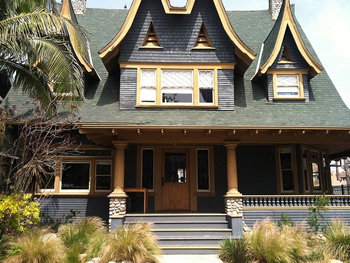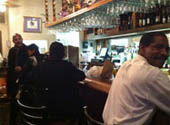Listen to an audio story from Annenberg Radio News:
West Adams is filled with grand, old Victorian homes, but near the freeway off of Arlington Street, one of these houses sticks out like a sore “blue” thumb. It features Polynesian-style gables that seem to slope forever and pillars made with the same stone that line the streets. It was known for years as the South Seas or the Tahitian house.
 It is a landmark and a piece of history, but these days, it’s something else entirely: a recreation center.
It is a landmark and a piece of history, but these days, it’s something else entirely: a recreation center.
“When I was told that I was coming here, I had no idea what this place was, so I said give me the address let me find out what this is so I driven up here and I said ‘it’s an actual house!’” said Carlton Stubbs, Recreation Coordinator at the South Seas House.
Stubbs’ job was to create unique programs for the unique house. The most popular include summer camp and computer classes. It’s a tight-nit group of kids, many of whom Stubbs hires back as counselors. Todd Hightower has been working there for six years. He says the South Seas House feels like home to all of the people who visit it.
“I grew up in the neighborhood so it kinda feels good to still be working in the neighborhood and it’s kinda good to be giving back,” said Hightower.
 Joseph Depuy built the home in 1902 and it stayed in his family until the 1970s. The city bought it for a street-widening project that would never happen. When plans took shape to demolish the house in the mid-90s, the community stepped in. Laura Meyers formed the South Seas House Action Committee with many other members of the community. She says saving the house became something more during a turbulent time in Los Angeles history.
Joseph Depuy built the home in 1902 and it stayed in his family until the 1970s. The city bought it for a street-widening project that would never happen. When plans took shape to demolish the house in the mid-90s, the community stepped in. Laura Meyers formed the South Seas House Action Committee with many other members of the community. She says saving the house became something more during a turbulent time in Los Angeles history.
“It became a symbol if you could rebirth the house you can rebirth the community,” said Meyers.
After a $1.5 million dollar restoration, the South Seas House reopened as a recreation center in 2003. With the house revitalized, the surrounding area followed. The park next door became a place for families instead of gang members. Stubbs says in all his time working at different centers in the city, he’s never seen so much commitment from a community.
“A lot of what went into this house was community driven. A lot of love was put into it by the community so they have a stake in it, which is how all communities should be,“ said Stubbs.
Today, the South Seas House looks exactly the same as it did in 1902, but with a fresh coat of blue paint and yellow trim and with a few more kids running around.









 “He was a good kid, never been in any trouble, never been arrested, never been suspended from school,” said Shaw.
“He was a good kid, never been in any trouble, never been arrested, never been suspended from school,” said Shaw. In 1969, New Orleans transplants Harold and Belle Legaux opened a new hot spot in the Jefferson Park area of Los Angeles. Creole food, atmosphere, jazz music, and good drinks were served every night at Harold & Belles. It became in institution.
In 1969, New Orleans transplants Harold and Belle Legaux opened a new hot spot in the Jefferson Park area of Los Angeles. Creole food, atmosphere, jazz music, and good drinks were served every night at Harold & Belles. It became in institution.




